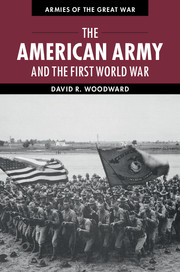Book contents
- Frontmatter
- Dedication
- Contents
- List of figures
- List of maps
- List of tables
- Preface
- List of abbreviations
- Introduction
- 1 Birth of a modern army
- 2 World war and American preparedness
- 3 Coercive power and Wilsonian diplomacy
- 4 “You’re in the army now”
- 5 US army doctrine and industrialized trench warfare
- 6 Over where?
- 7 American Expeditionary Force organization, overseas training, and deployment
- 8 Will the Americans arrive in time?
- 9 Failed expectations: “the military establishment of the United States has fallen down”
- 10 Atlantic ferry
- 11 Neck of the bottle
- 12 Uncertain times
- 13 Cantigny
- 14 Into the breach
- 15 American soldiers in north Russia and Siberia
- 16 The beginning of the end
- 17 Establishment of the American First Army and Saint-Mihiel
- 18 Meuse-Argonne, September 26–October 31
- 19 Breakout, November 1–11
- 20 Epilogue
- Notes
- Bibliography
- Index
16 - The beginning of the end
Published online by Cambridge University Press: 05 July 2014
- Frontmatter
- Dedication
- Contents
- List of figures
- List of maps
- List of tables
- Preface
- List of abbreviations
- Introduction
- 1 Birth of a modern army
- 2 World war and American preparedness
- 3 Coercive power and Wilsonian diplomacy
- 4 “You’re in the army now”
- 5 US army doctrine and industrialized trench warfare
- 6 Over where?
- 7 American Expeditionary Force organization, overseas training, and deployment
- 8 Will the Americans arrive in time?
- 9 Failed expectations: “the military establishment of the United States has fallen down”
- 10 Atlantic ferry
- 11 Neck of the bottle
- 12 Uncertain times
- 13 Cantigny
- 14 Into the breach
- 15 American soldiers in north Russia and Siberia
- 16 The beginning of the end
- 17 Establishment of the American First Army and Saint-Mihiel
- 18 Meuse-Argonne, September 26–October 31
- 19 Breakout, November 1–11
- 20 Epilogue
- Notes
- Bibliography
- Index
Summary
Time was running out for the Germans. The trickle of American reinforcements had turned into a torrent. Ludendorff’s four previous offensives in 1918 had cost him some 500,000 casualties; meanwhile the youth of America poured across the Atlantic, infusing hope and energy into the war-weary Allied forces. Prior to Germany’s last offensive of the war in July, the German Chief of the General Staff of the Field Army, Foreign Armies, submitted the following assessment: “Considering its small experience of war and defective training the combat value of the American division can in general be described as good. In defense even the most recently arrived troops represent an opponent worthy of respect. The American soldier shows himself to be brave, strong, and skillful. Losses are not avoided. However their leadership is not yet all that good.”
In the Marne salient, the French commander-in-chief, Henri-Philippe Pétain, had in mid-July three US divisions on the western flank of the Marne salient, two at the base and one supporting General Henri Gouraud’s Fourth Army. Elsewhere unbloodied US divisions occupied quiet sectors in Alsace-Lorraine or trained with the French and British. Many more divisions apparently were on the way, for Pershing had made a commitment to the British and French in June (unrealistic as it turned out) to ship 100 divisions to France by July 1919.
- Type
- Chapter
- Information
- The American Army and the First World War , pp. 276 - 297Publisher: Cambridge University PressPrint publication year: 2014

